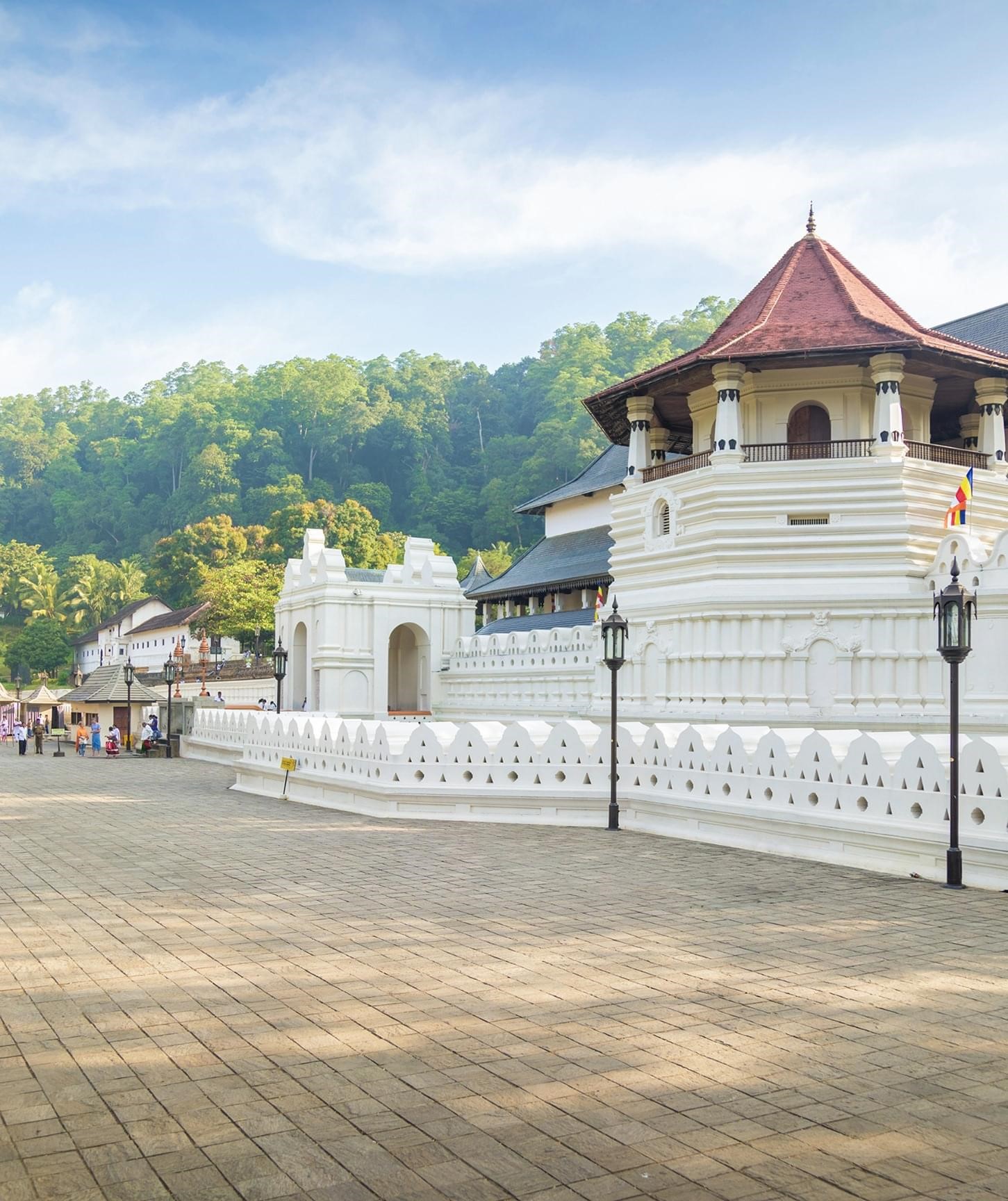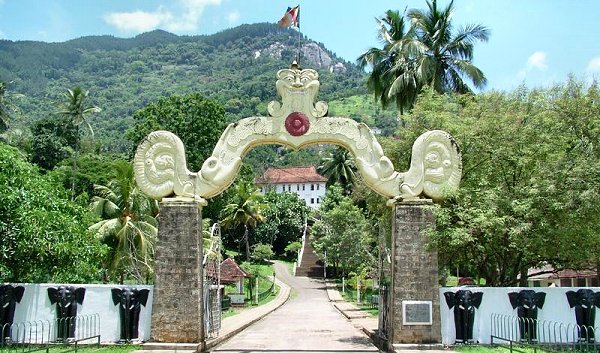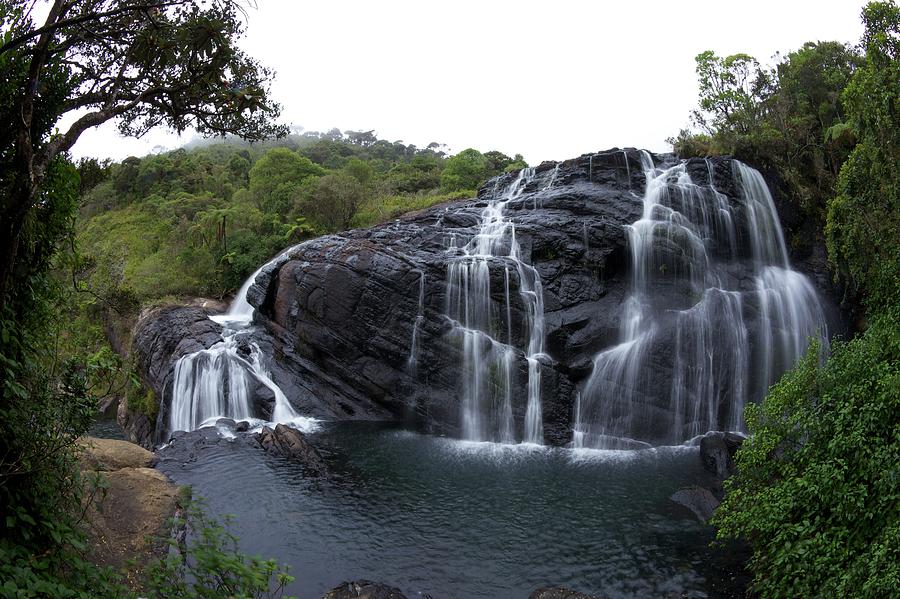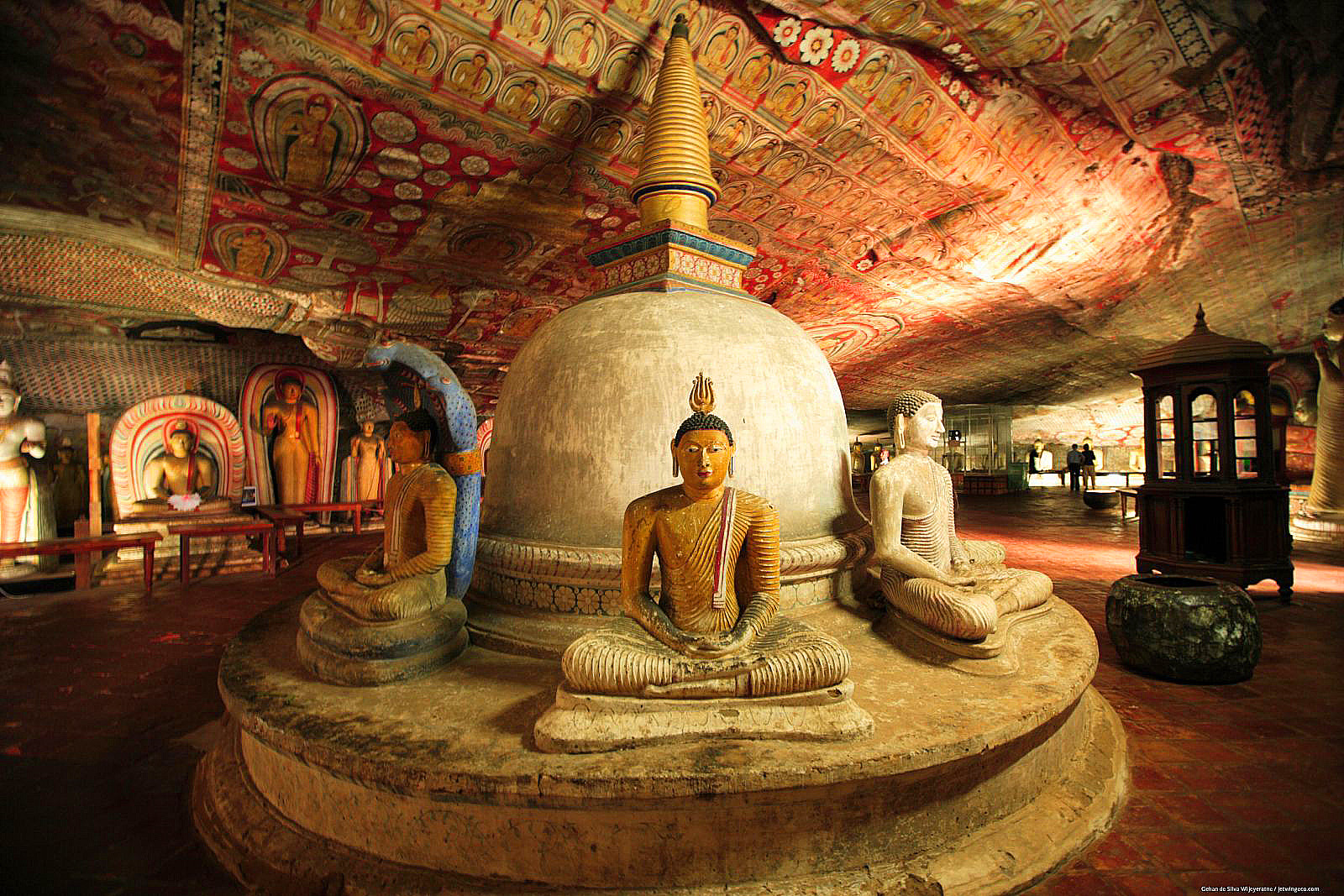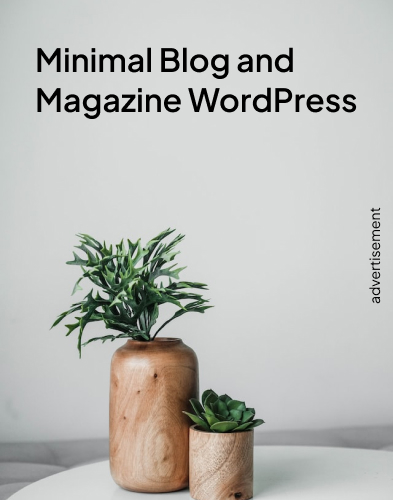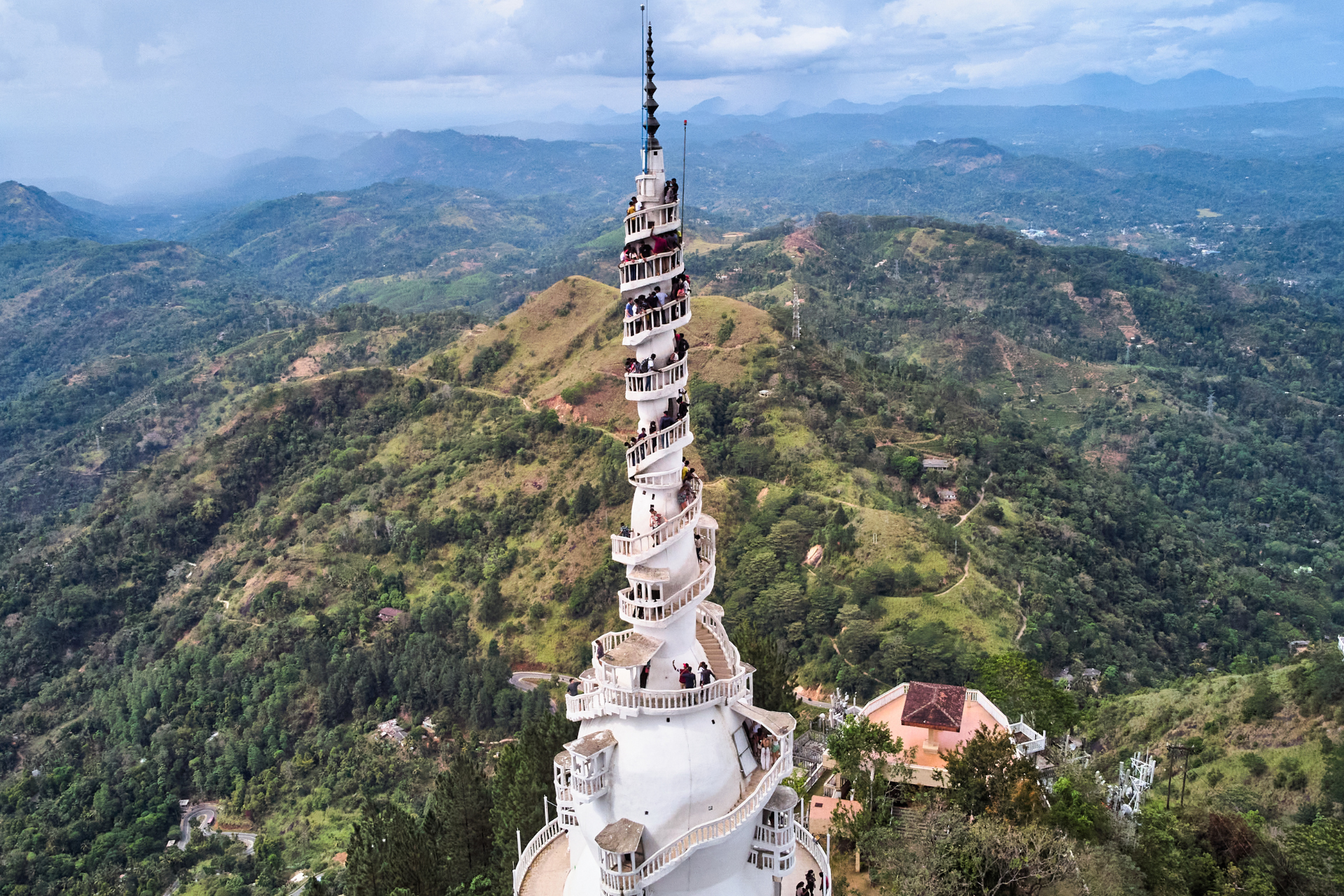Visiting Sri Dalada Maligawa: The Sacred Temple of the Tooth
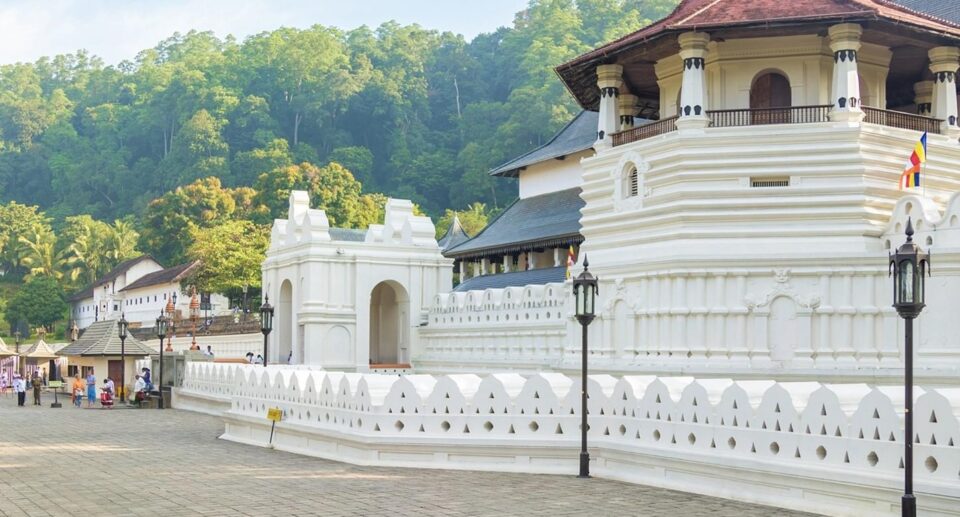
Located in the heart of Kandy, Sri Lanka, the Kandy Sri Dalada Maligawa, also known as the Temple of the Sacred Tooth Relic, is one of the most revered Buddhist temples in the world. Within its walls lies the relic of the Buddha’s tooth, which made it a great pilgrimage center for Buddhists all around the world. Kandy Sri Dalada Maligawa more commonly known in English as the Temple of the Sacred Tooth Relic, is a Buddhist temple in Kandy, Sri Lanka. Within the Royal Palace Complex of the former Kingdom of Kandy,Sri Lanka. it houses the relic of the tooth of the Buddha. Since ancient times, the relic had a significant position in local politics because it is believed that whoever holds the relic holds the governance of the country in Sri Lanka. The relic historically was held by Sinhalese kings. The temple of the tooth is a World Heritage Site mainly due to the temple and the relic.
Daily worship within the inner chamber of the temple is conducted by Bhikkhus of the two particular chapters – Kandy Malwathu chapters and Asgiri chapters. Rituals are performed three times daily: at dawn, at noon, and in the evenings. On Wednesdays, there is the symbolic bathing of the relic with a herbal preparation made from scented water and fragrant flowers called Nanumura Mangallaya. This holy water is believed to have healing powers and is distributed to those present.
Sri Dalada Maligawa History
According to legend, this tooth relic was preserved in Kalinga after the Maha parinirvana of Gautama Buddha and smuggled to the island by Princess Hemamali and her husband, Prince Dantha, on the instructions of her father King Guhasiva. They arrived with it at Lankapattana Island during the reign of Anuradhapura’s Sirimeghavanna (301-328). The king placed it in the Meghagiri Vihara (now Isurumuniya) in Anuradhapura. The monarch became responsible for protecting the relic, so eventually, for generations to come, the custodianship of the relic came to signify the right to rule Lanka Island. Therefore, reigning monarchs built the tooth relic temples quite close to their royal residences, as was the case during the times of the Anuradhapura Kingdom, Kingdom of Polonnaruwa, and Kingdom of Dambadeniya. In the case of the Kingdom of Gampola, the relic was kept in Niyamgampaya Vihara. According to messenger poems like Hamsa, Gira, and Selalihini, the temple of tooth relic was within the city of Sri Jayawardenapura Kotte when the Kingdom of Kotte was established there.
Historical Significance
Ancient Origin: This relic of a tooth was brought to Sri Lanka in the 4th century AD from India by Princess Hemamali and Prince Dantha. It was housed first in numerous places before finally being placed in Kandy.
Royal Patronage: The temple has been under the protection and patronage of the kings of Sri Lanka for centuries. Different Kings built various buildings around the temple complex, which add to its grandeur and prestige.
Paththirippuwa, front view
In the reign of Dharmapala of Kotte, the relic was moved and was hidden in Delgamuwa Vihara, Ratnapura, in a grinding stone. Hiripitiye Diyawadana Rala and Devanagala Rathnalankara Thera brought it to Kandy. A two-storey building was built by King Vimaladharmasuriya I to deposit the tooth relic, and that building is now gone. In 1603 when the Portuguese kingdom invaded Kandy, it was carried to Meda Mahanuwara in Dumbara. It was recovered during the time of Rajasinha II and it has been reported that he reinstated the original building or built a new temple. The present day Kandy temple of the tooth was built by Vira Narendra Sinha. The octagonal Paththirippuwa and the moat were added during the reign of Sri Vikrama Rajasinha. It is said that the royal architect Devendra Moolacharya built the Paththirippuwa. First used for the recreation of the king, later offered to the tooth relic, it now houses the temple’s library.
Architecture
Central Temple: Its structure is a wonderful amalgamation of Kandyan, South Indian, and Thai styles. Elaborate carvings, paintings, and frescoes decorate the two-story structure.
Golden Canopy: One of the most striking features of the temple is the recent addition of a golden canopy over the main shrine to protect and highlight the sacred relic.
Sacred Tooth Relic: The tooth relic enshrined in a series of golden caskets is said to bestow upon the divine right to rule thus, the temple is politically as well as religiously symbolic.Daily Rituals: Daily worship rituals are done thrice a day by monks of the two chapters of Malwatte and Asgiriya, accompanied by traditional music playing and drumming.
Esala Perahera: July/August sees one of Sri Lanka’s biggest and most spectacular festivals, the Esala Perahera. This is an opening procession of traditional dancers, drummers, elephants, and torchbearers that features the extremely rich cultural heritage on the island. The brick wall running along the moat and the Bogambara lake is called the water waves wall. Holes in this wall are built to light coconut oil lamps. The main entrance gate, which lies over the moat, is called Mahawahalkada. At the foot of the Mahawahalkada steps is a Sandakada pahana (moonstone) executed in Kandyan architectural style. Mahawahalkada was totally destroyed in a 1998 bomb blast and rebuilt afterwards along with Sandakada pahana other stone carvings. Elephants are carved in stone on either side of the entrance. A Makara Torana and two guardian stones are placed at the top of the staircase. The Hewisi drummers’ chamber is in front of the main shrine. The two storeys of the main shrine are known as “Palle Malaya” (lower floor) and “Udu Malaya” (upper floor) or “Weda hitina maligawa”.The doors of the Weda Hitana Maligawa are Ivory carvings. The actual chamber in which the tooth relic is kept is known as the “Handun kunama”.
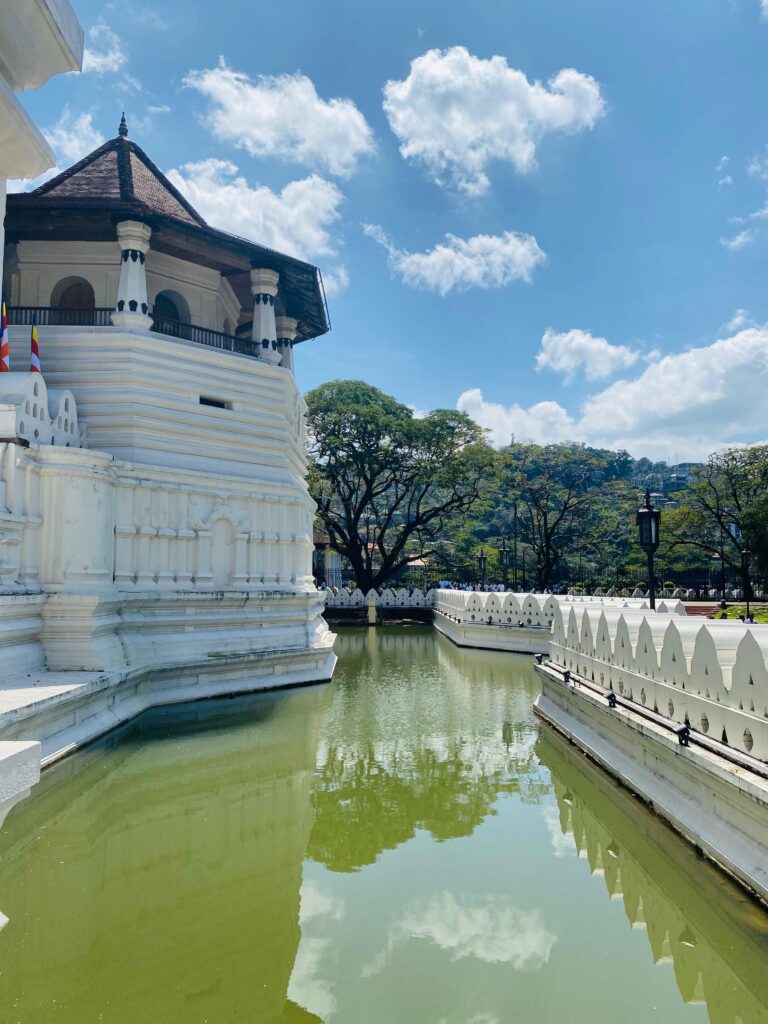
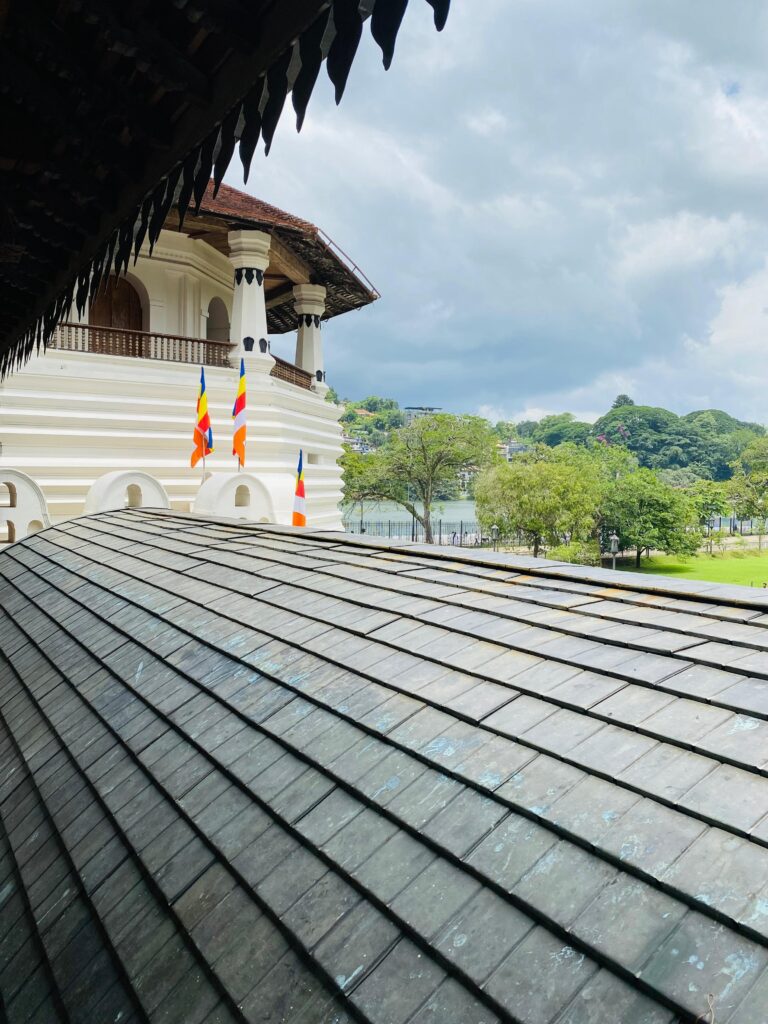
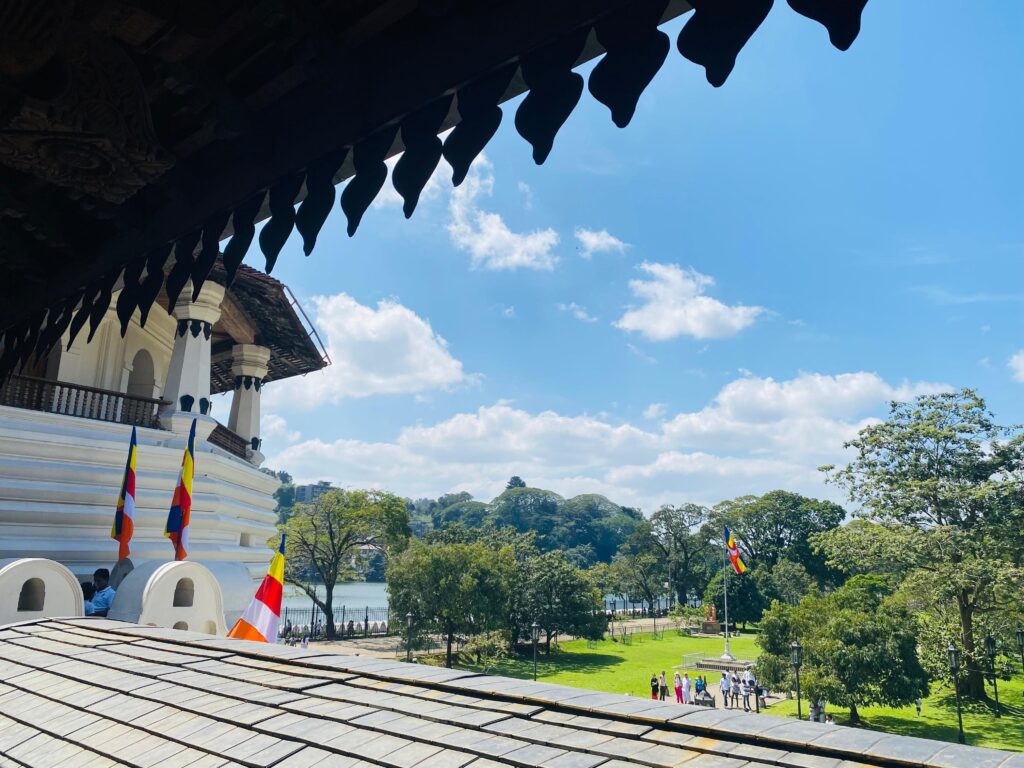
The golden canopy over the main shrine and the golden fence which encircles the temple complex, was built in 1987 by then Prime Minister, Ranasinghe Premadasa. The tooth relic is encased in seven golden caskets which are engraved with precious gemstones. The casket represent a stupa the procession casket which is used during the Kandy Esala Perahera is also displayed in the same chamber.
Royal Palace & Park
Located next to the Temple of the Sacred Tooth Relic (Sri Dalada Maligawa) overlooking the Kandy Lake, the Royal Palace of Kandy was the last royal residence of the Kingdom of Kandy. In the palace last resided King Sri Wickrama Rajasinha until he was overthrown by the British in 1815. The Royal Palace and its picturesque park built by King Sri Wickrama Rajasinha add much magnificence to the Temple of the Sacred Tooth Relic.
Rajah Tusker Hall
In the Rajah Tusker Hall are the stuffed remains of the noble Tusker ‘Rajah’ who carried the casket of the Sacred Tooth Relic in the Kandy Esala Perahera for 37 years and took part in the Esala Perahera for about 50 years until his death in 1988. Rajah possessed the rare Maha Gaja Lakshana physical characteristics that put him in the aristocratic caste of Sri Lankan elephants, Chaddhantha.
Audience Hall
The audience hall or magul maduwa is where the Kandyan kings held their court.[12] It was completed during the reign of Sri Vikrama Rajasinha.[13] The carvings of the wooden pillars which support the wooden roof are an example of wood carving of the Kandyan period. This was built by Sri Rajadhi Rajasinha of Kandy in 1783. This hall was renovated for the reception held for the arrival of Albert Edward, Prince of Wales in 1872. The length of the hall was 58 by 35.6 feet; after renovation, it was extended by an additional 31.6 feet. Other nearby buildings to the halls are believed to have been demolished during the British rule. The hall of the audience was where the Kandyan Convention was drawn up, where it was read out to the people, and where the conference about the convention took place on 2 March 1815. That space was later used in erecting the Kandy Kachcheri and the Kandy Supreme Court. Today, it is used for state ceremonies and conserved under the Department of Archaeology.
Asgiriya Maha Vihara
Lying off Wariyapola Sri Sumanga Mawatha (a street) northwest of the city centre, the Asgiriya Maha Vihara is one of the two principal Viharas (temples) in the city of Kandy and is of vital importance. Mahanayake Thera (chief prelate) is the chief incumbent of the temple and also the head monk of the Asgiriya Chapter, who administers the Temple of the Sacred Tooth Relic.
Malwatte Maha Vihara
Another Vihara of the two principal Viharas in Kandy, Malwatte Maha Vihara is of vital importance. Mahanayake Thera (chief prelate) heads the Vihara and also the Malwatte Chapter. In the Vihara resides the Mahanayake Thera who administers the Temple of the Sacred Tooth Relic.
The Four Great Devales
The Four Great Devales are comprised of Natha Devale, Pattini Devale, Vishnu Devale and Kataragama Devale, all of which are located close by the Temple of the Sacred Tooth Relic. Devales are shrines or temple complexes dedicated to particular Gods who protect Buddhism, the country and its people against evils. These four devales have a longstanding association with the Royal Palace (Maha Vasala) and the Temple of the Sacred Tooth Relic (Sri Dalada Maligawa). Four Peraheras (processions) organized by each of the four devales take part in the ‘Kandy Esala Perahera’ that consists of Dalada Perahera and four devale peraheras.
Natha Devale
is dedicated to God Natha who is believed to be still battling to protect Buddhism from Mara and has sent gods from the heaven to the earth to protect Buddhism. The available facts bear evidence to the fact that the Natha Devale has been in existence since the time before the Sacred Tooth Relic was brought to Kandy. Located on the terrace in front of the palatial complex, built by King Vickramabahu III, the Natha Devale is therefore the oldest of the four devales dating back to the 14th century.
Vishnu Devale
alias ‘Maha Devale’ which is dedicated to God Vishnu is located north of the Natha Devale in the palatial complex and can be reached through a flight of carved stone steps. The God Vishnu alias Alut Nuwara Deiyo is believed to be the protector or the guardian of Buddhism and the country.
Pattini Devale
is yet another devale of the four devales. Located west of the Natha Devale, the Pattini Devale is dedicated to Goddess Pattini- the Goddess of Virginity. The Goddess is believed to be the curer of infectious diseases especially of children’s and also blessings of the God Pattini are invoked in times of drought and consequent famine.
Kataragama Devale
is the shrine complex dedicated to the God Skanda alias Murugan and Kataragama Deiyo who has 6 heads and 12 hands holding weapons. Worshiped by Buddhists and Hindus alike, the God Skanda is considered the god of war. Unlike other three devales, Kataragama Devale is located a little bit away from the palatial complex. The Devale lies at Kotugodella Veediya (a street in Kandy).
Mahamaluwa
Mahamaluwa itself is open to the public who come to see the annual Kandy Esala perahera. Today it contains a statue of Madduma Bandara. Another attraction is the memorial containing the skull of Keppetipola Disawe. The statues of Princess Hemamali and Prince Dantha are also kept here.
Sri Dalada Museum
Sri Dalada Museum is located on the first and second floors of the Alut Maligawa, a new wing lying behind the temple of the Sacred Tooth Relic. Dozens of various gifts offered to the temple of the Sacred Tooth Relic by various devotees around the world including heads of states, are showcased in the museum.
On the first floor, a lot of historical records including letters and diary entries from the British colonial era, the 1765 Dutch Plan of the Palace Complex, and also royal costume of King Kirti Sri Rajasinha, etc., are on display while a number of historical artifacts used in the daily ritual ceremonies of the Dalada Maligawa, caskets, Buddha statues and typical Kandyan gold and silver jewellery studded with precious gemstones and many more are showcased on the second floor. Also on display are photographs, some of which reveal the damage caused to the Sri Dalada Maligawa by the terrorist attack in 1998.
(The museum is open for public from Saturday to Thursday 0900hrs- 1700hrs)
Kandy National Museum
Built during the reign of King Sri Wickrama Rajasinha, the building, where the museum is now housed was the royal concubines then known as “Palle Vahala”. Located east of the Sri Dalada Maligawa, the National Museum showcases over 5000 artifacts and objects depicting various aspects of historical and cultural events of the Kandyan period (17-19 century A.D.) including royal regalia and reminders of pre-European Sinhalese life. Among on display is also a copy of the 1815 Kandyan Convention that ceded the Kandyan Kingdom to Britain.
(The museum is open for public from Saturday to Thursday 0900hrs- 1700hrs)
International Buddhist Museum
The International Buddhist Museum is the world’s first International Buddhist Museum. It lies adjacent to the National Museum of Kandy and Temple of the Tooth in Kandy, Sri Lanka, on a site that formerly was the Palace of the Kandian King, Wimaladharmasuriya, upon which the British constructed a building in the Victorian era, housing the Kandy Kachcheri. The contribution from 17 countries—Sri Lanka, India, Bangladesh, Nepal, Pakistan, Japan, China, Korea, Indonesia, Thailand, Myanmar, Laos, Vietnam, Cambodia, Malaysia, Bhutan, and Afghanistan—has brought about this museum.
Kandy Lake
Built in 1807 by King Sri Wickrama Rajasinha, the last Sinhalese king of Sri Lanka, Kandy Lake that adds much beauty to the splendorous city of Kandy lies in the heart of the city beside the Temple of the Sacred Tooth Relic (Sri Dalada Maligawa). Forced labour is said to have been used by the king for the construction of the lake and those who objected to this were ruthlessly killed.
The lake surrounded by an ornate wall of 2060 ft in length lies in a parameter of 2.1 miles and the depth of which is about 60 ft. The islet in the centre of the lake was used by the King Sri Wickrama Rajasinha as his private harem and the Royal Bathhouse was used by the king’s wives and concubines as a bathhouse.
When you visit Kandy, the surrounding area of the Kandy Lake filled with cool breeze coming from the lake and nearby forests is an ideal place for you to spend a few hours walking leisurely on the shady path round the lake and enjoying the scenic views of the hills and the historic city and the most stunning view is the Temple of the Sacred Tooth Relic lying on the backdrop. Also you could enjoy boat rides on the lake.
Small artificial island
There are hundreds of local legends and items of folklore about the lake. One such is that the small island at its center was used by the king’s harem for bathing and was connected to the palace by a secret tunnel. The area of Kandy Lake is 6,544 sq. meters. The perimeter is 3.21 km. The maximum depth is 18.5 meters. The parapet wall, resembling a cloud, is commonly known as Walakulu Bemma and is 633.82 meters. The structure in the middle of the lake, along with some remains of antiquity, was once named Diyatilaka Mandapaya. It is said that the Kings used this hall as a recreation hall. The leisure facilities include walking or jogging around the Kandy Lake. The shady path offers fine views of the hills and the town. The Malwatte temple is the other head temple of the Siyam Nikaya sect of Theravada Buddhism and overlooks the lake.
Pothgul Vihara
Pothgul Vihara that has been in existence for about seven decades is a Buddhist temple located in close proximity to the Temple of the Sacred Tooth Relic, perching on the foothills of the famous Udawattekelle Sanctuary, overlooking the breathtaking views of the splendid city of Kandy. The word ‘Pothgula’ means ‘Library’ in English. During the British colonial rule, the ancient library known as ‘Keerthi Sri Rajasinha Pothgula’ located at the Temple of the Sacred Tooth Relic was ruined.
Hence, the then Chief Lay Custodian of the Temple of the Sacred Tooth Relic, C B Nugawela initiated to build a temple in close proximity to the Temple of the Sacred Tooth Relic. Accordingly, in 1946, the temple was built and it was named as ‘Keerthi Sri Rajasingha Pothgul Vihara’ in memory of the ancient library. Then, to fill the void of the ancient library at the Temple of the Sacred Tooth Relic, a library was established within the temple and was filled with books of historical Buddhist literature most of them written on Ola
When you visit Kandy, this temple is worth stepping in.
Diyathilaka Mandapaya
Sri Wickrama Rajasinghe built a dam to cross over to the other side of the lake. At both ends, palace end and Malwatte Vihare end, the king removed the soil, leaving behind an island. Initially, it was used as the Royal Summer House for the Queen and the ladies of the court to spend their leisure time. Later, the British used it as an ammunition store and surrounded its perimeter with a fortress-style parapet.
Walakula Bamma
Walakulu Bamma, literally a wall of clouds was constructed around Kandy Lake to enhance its beauty. It stretches for about half the circumference of the lake but took only one able architect to erect it. Sri Wickrama Rajasinghe couldn’t construct the wall since the city was captured by the British before he finished his work, and therefore compellingly gave up the Kandian kingdom. The Walakulu Bamma still lies unfinished. Triangular shaped holes in the wall, used to hold lighting oil lamps on festival days.
Walakulu Bamma, literally a wall of clouds was constructed around Kandy Lake to enhance its beauty. It stretches for about half the circumference of the lake but took only one able architect to erect it. Sri Wickrama Rajasinghe couldn’t construct the wall since the city was captured by the British before he finished his work, and therefore compellingly gave up the Kandian kingdom. The Walakulu Bamma still lies unfinished. Triangular shaped holes in the wall, used to hold lighting oil lamps on festival days.
Ulpange
Ulpange or Queens Bathing Pavilion is situated partly in the waters of the Kandy Lake. It was used by the wives and concubines of Sri Wickrama Rajasinghe when bathing in the Kandy lake. After capturing the city the British added another storey and used the building as a library. It is currently used as a police post.

